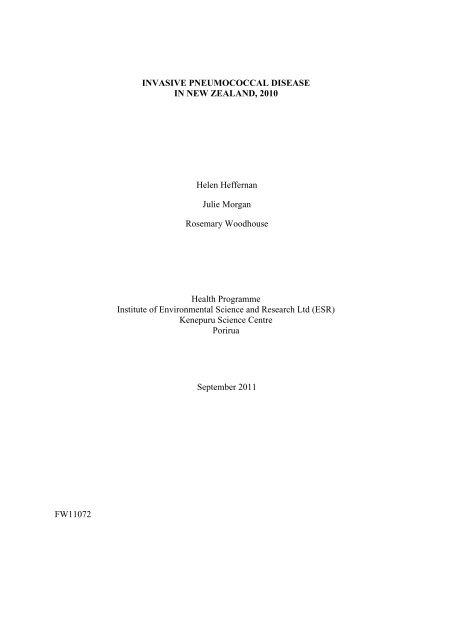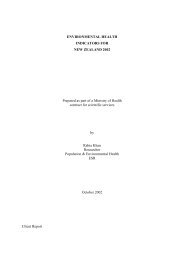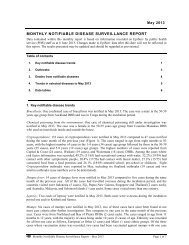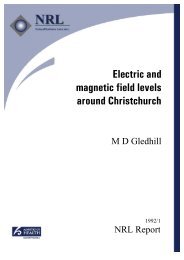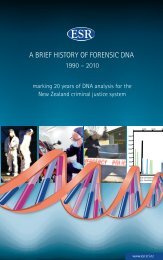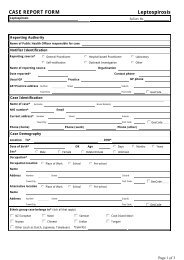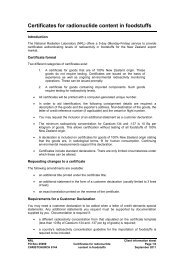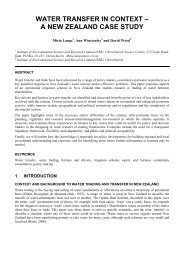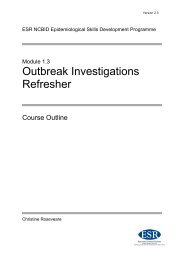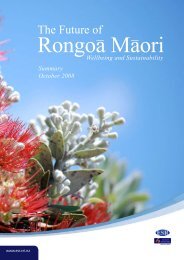Invasive Pneumococcal Disease in New Zealand, 2010
Invasive Pneumococcal Disease in New Zealand, 2010
Invasive Pneumococcal Disease in New Zealand, 2010
Create successful ePaper yourself
Turn your PDF publications into a flip-book with our unique Google optimized e-Paper software.
INVASIVE PNEUMOCOCCAL DISEASEIN NEW ZEALAND, <strong>2010</strong>Helen HeffernanJulie MorganRosemary WoodhouseHealth ProgrammeInstitute of Environmental Science and Research Ltd (ESR)Kenepuru Science CentrePoriruaSeptember 2011FW11072
INVASIVE PNEUMOCOCCAL DISEASEIN NEW ZEALAND, <strong>2010</strong>Prepared as part of the M<strong>in</strong>istry of Healthcontract for scientific servicesHelen HeffernanProject LeaderKerry SextonPeer Reviewer
DISCLAIMERThis report or document (“the Report”) is provided by the Institute of Environmental Scienceand Research Limited (“ESR”) solely for the benefit of the M<strong>in</strong>istry of Health, District HealthBoards and other Third Party Beneficiaries as def<strong>in</strong>ed <strong>in</strong> the Contract between ESR and theM<strong>in</strong>istry of Health. It is strictly subject to the conditions laid out <strong>in</strong> that Contract.Neither ESR, nor any of its employees, makes any warranty, express or implied, or assumesany legal liability or responsibility for use of the Report or its contents by any other person ororganisation.<strong>Invasive</strong> pneumococcal disease September 2011<strong>in</strong> NZ, <strong>2010</strong>
ACKNOWLEDGEMENTSPublic Health Unit staff for provision of notification data for their regions.Diagnostic microbiology laboratories throughout <strong>New</strong> <strong>Zealand</strong> who participate <strong>in</strong> the nationallaboratory-based surveillance of <strong>in</strong>vasive pneumococcal disease by referr<strong>in</strong>g isolates to ESR.Barbara Bowen, Ushma Desai and Er<strong>in</strong> Higg<strong>in</strong>s, ESR Antibiotic Reference Laboratory, forantimicrobial susceptibility test<strong>in</strong>g; Heather Davies, ESR <strong>Invasive</strong> Pathogens Laboratory, forserotyp<strong>in</strong>g data; Esther Lim, ESR Health Group, for help with the <strong>in</strong>vasive pneumococcaldisease notification data; and Tim Wood, ESR Health Group, for help with the analysis of theNational Immunisation Register data.<strong>Invasive</strong> pneumococcal disease September 2011<strong>in</strong> NZ, <strong>2010</strong>
CONTENTSSUMMARY ................................................................................................................................ i1. INTRODUCTION ........................................................................................................... 12. METHODS ....................................................................................................................... 22.1 Surveillance methods ............................................................................................ 22.2 Laboratory methods .............................................................................................. 32.3 Case def<strong>in</strong>ition ...................................................................................................... 32.4 Abbreviations ........................................................................................................ 43. RESULTS ......................................................................................................................... 53.1 Laboratory criteria upon which diagnosis based ................................................... 53.2 <strong>Disease</strong> <strong>in</strong>cidence by age ...................................................................................... 53.3 <strong>Disease</strong> <strong>in</strong>cidence by season ................................................................................. 83.4 <strong>Disease</strong> <strong>in</strong>cidence by ethnicity .............................................................................. 93.5 <strong>Disease</strong> <strong>in</strong>cidence by deprivation ........................................................................ 103.6 <strong>Disease</strong> presentation, fatalities and hospitalisation ............................................. 113.7 Risk factors among IPD cases ............................................................................. 123.8 Immunisation status of cases ............................................................................... 133.9 Incidence by district health board ....................................................................... 143.10 Serotype distribution ........................................................................................... 153.11 Antimicrobial susceptibility ................................................................................ 194. DISCUSSION ................................................................................................................. 22REFERENCES ........................................................................................................................ 25Appendix 1.Appendix 2.Appendix 3.Appendix 4.Appendix 5.Laboratory criteria upon which <strong>in</strong>vasive pneumococcal disease diagnosisbased, as recorded <strong>in</strong> the case notification, <strong>2010</strong> ............................................ 27Age distribution among <strong>in</strong>vasive pneumococcal disease cases
Appendix 10.Appendix 11.Appendix 12.Appendix 13.Appendix 14.Appendix 15.Penicill<strong>in</strong> and cefotaxime MIC distribution of pneumococci from <strong>in</strong>vasivedisease, <strong>2010</strong> ................................................................................................... 36Trends <strong>in</strong> penicill<strong>in</strong> resistance, cefotaxime resistance and multidrug resistanceamong pneumococci from <strong>in</strong>vasive disease, 2001-<strong>2010</strong> ................................. 37Trends <strong>in</strong> resistance to non-β-lactam antibiotics, among pneumococci from<strong>in</strong>vasive disease, 2001-<strong>2010</strong> ............................................................................ 38Penicill<strong>in</strong> and cefotaxime resistance among isolates from <strong>in</strong>vasivepneumococcal disease by region and district health board (DHB), <strong>2010</strong> ....... 39Serotypes among penicill<strong>in</strong> resistant, cefotaxime resistant and <strong>in</strong>termediate,and multiresistant isolates from <strong>in</strong>vasive pneumococcal disease cases, <strong>2010</strong> 40Trends <strong>in</strong> penicill<strong>in</strong> resistance, cefotaxime resistance and multidrug resistanceamong serotype 19A pneumococci from <strong>in</strong>vasive disease, 2001-<strong>2010</strong> .......... 41<strong>Invasive</strong> pneumococcal disease September 2011<strong>in</strong> NZ, <strong>2010</strong>
SUMMARYA 4-dose schedule of the 7-valent pneumococcal conjugate vacc<strong>in</strong>e (PCV-7), Prevenar®, wasadded to the <strong>New</strong> <strong>Zealand</strong> childhood immunisation schedule <strong>in</strong> June 2008, with a catch-upprogramme for all children born on or after 1 January 2008. S<strong>in</strong>ce 17 October 2008, <strong>in</strong>vasivepneumococcal disease (IPD) has been notifiable to medical officers of health under theHealth Act 1956.In this report, the data presented for 2009 and <strong>2010</strong> is based on IPD case notificationssupplemented with serotype and antimicrobial susceptibility data from ESR‟s nationallaboratory-based surveillance of <strong>in</strong>vasive Streptococcus pneumoniae isolates. Data for earlieryears is solely from ESR‟s laboratory-based surveillance. For this laboratory-basedsurveillance, diagnostic microbiology laboratories are requested to refer all <strong>in</strong>vasive isolatesof S. pneumoniae to ESR for serotyp<strong>in</strong>g and antimicrobial susceptibility test<strong>in</strong>g.There were 535 cases of IPD notified <strong>in</strong> <strong>2010</strong>, which equates to a rate of 12.2 cases per100 000. A S. pneumoniae isolate from an <strong>in</strong>vasive site was received at ESR for serotyp<strong>in</strong>gand susceptibility test<strong>in</strong>g for 514 (96.1%) of the notified cases.The <strong>in</strong>cidence of IPD <strong>in</strong> <strong>in</strong>fants
SUMMARY cont<strong>in</strong>uedThere were no significant regional differences (P ≤0.05) <strong>in</strong> the <strong>in</strong>cidence of IPD <strong>in</strong> <strong>2010</strong>, butwith<strong>in</strong> the Northern region disease rates were significantly higher <strong>in</strong> Counties ManukauDistrict Heath Board (DHB) than <strong>in</strong> the other three DHBs <strong>in</strong> the region.Among the 34 cases who had received ≥1 dose of PCV-7, and for whom the serotype caus<strong>in</strong>gdisease was known, 27 (79.4%) had IPD due to a non-PCV-7 type. Of the seven cases whohad received ≥1 dose of PCV-7 and had disease due to a PCV-7 type, five had serotype 19Fdisease, one had type 6B disease and one had type 14 disease.There has been some <strong>in</strong>crease <strong>in</strong> IPD caused by non-PCV-7 serotypes s<strong>in</strong>ce the <strong>in</strong>troductionof PCV-7. This <strong>in</strong>crease has been predom<strong>in</strong>antly due to serotype 1 disease. An <strong>in</strong>crease <strong>in</strong>serotype 1 IPD was first noted <strong>in</strong> 2007 and appears to have peaked <strong>in</strong> 2009, with the rate oftype 1 disease halv<strong>in</strong>g between 2009 and <strong>2010</strong>. Except for 2009, most of the serotype 1disease has been <strong>in</strong> cases 5-34 years of age. In 2009, this type also became common among<strong>in</strong>fants
1. INTRODUCTIONPrior to 2009, the national surveillance of <strong>in</strong>vasive pneumococcal disease (IPD) <strong>in</strong><strong>New</strong> <strong>Zealand</strong> was solely laboratory based, with diagnostic laboratories referr<strong>in</strong>g <strong>in</strong>vasiveisolates of Streptococcus pneumoniae to the Institute of Environmental Science and ResearchLtd (ESR) for serotyp<strong>in</strong>g and antimicrobial susceptibility test<strong>in</strong>g. This laboratory-basedsurveillance provided <strong>in</strong>formation on the basic epidemiology of IPD, and the serotypes andantimicrobial susceptibility of <strong>in</strong>vasive isolates. Information from this laboratory-basedsurveillance was published periodically. 1-5 In addition, between 2002 and 2007, annualreports on the antimicrobial susceptibility of isolates from IPD cases have been published onESR‟s surveillance website athttp://www.surv.esr.cri.nz/antimicrobial/streptococcus_pneumoniae.php.The first of this series of annual reports on IPD <strong>in</strong> <strong>New</strong> <strong>Zealand</strong> covered IPD <strong>in</strong> 2008 and wasbased on data available from ESR‟s national laboratory-based surveillance. 6 On 1 June 2008,the 7-valent pneumococcal conjugate vacc<strong>in</strong>e (PCV-7), Prevenar®, was added to the <strong>New</strong><strong>Zealand</strong> childhood immunisation schedule and IPD became a notifiable disease on 17 October2008. The 2009 IPD annual report was the first to be based on IPD notifications,supplemented with serotype and antimicrobial susceptibility data from ESR‟s laboratorybasedsurveillance of <strong>in</strong>vasive S. pneumoniae isolates. 7Data on the IPD cases notified <strong>in</strong> <strong>2010</strong> is presented <strong>in</strong> this report, along with trend data forrecent years.<strong>Invasive</strong> pneumococcal disease 1 September 2011<strong>in</strong> NZ, <strong>2010</strong>
2. METHODS2.1 Surveillance methodsIn this report, data for 2009 and <strong>2010</strong> is based on IPD case notifications supplemented withserotype and antimicrobial susceptibility data from the laboratory-based surveillance of<strong>in</strong>vasive S. pneumoniae isolates. Data for earlier years is from ESR‟s national laboratorybasedsurveillance of IPD.S<strong>in</strong>ce 17 October 2008, IPD has been notifiable to medical officers of health under the HealthAct 1956. Data on each case is entered at public health units (PHUs), via a secure web-basedportal, onto a computerised database (EpiSurv). The notification data is collated andanalysed on behalf of the M<strong>in</strong>istry of Health by ESR.For the national laboratory-based surveillance of IPD, diagnostic microbiology laboratories <strong>in</strong><strong>New</strong> <strong>Zealand</strong> are requested to refer all <strong>in</strong>vasive isolates of S. pneumoniae [ie, isolates fromcerebrosp<strong>in</strong>al fluid (CSF), blood or other normally sterile site] to ESR. In addition and lessfrequently, laboratories refer sterile site specimens to ESR to test for the presence ofpneumococcal DNA by PCR. At ESR all <strong>in</strong>vasive isolates are serotyped and tested forsusceptibility to a range of antibiotics (see Section 2.2).The notification data <strong>in</strong> this report is based on the <strong>in</strong>formation recorded on EpiSurv as at17 February 2011. Any changes made to EpiSurv data by PHU staff after this date are notreflected <strong>in</strong> this report. Serotype and antimicrobial susceptibility data for <strong>in</strong>vasive isolateswas matched with the relevant case notification.Except for disease rates by ethnicity and deprivation <strong>in</strong>dex, mid-year <strong>New</strong> <strong>Zealand</strong>population estimates were used to calculate <strong>in</strong>cidence rates. The 2006 census population datawas used to calculate ethnicity-specific IPD rates, and a prioritised approach was used withthe order of prioritisation as: Māori, Pacific Peoples, Other (other groups except European),and European. 8 Incidence rates are not presented for categories where there were
Data analyses were performed with SAS software v.9.1.3 (SAS Institute Inc, Cary, NC,USA). The chi-square test or Fisher‟s exact test, as appropriate, were used to determ<strong>in</strong>e thesignificance of any observed differences. L<strong>in</strong>ear regression was used to calculate thesignificance and direction of time trends. An associated P value of 0.05 was used to identifywhether a difference or trend was significant.2.2 Laboratory methodsDetection of pneumococcal DNA <strong>in</strong> cl<strong>in</strong>ical specimens: The presence of pneumococcalDNA <strong>in</strong> cl<strong>in</strong>ical specimens is detected by polymerase cha<strong>in</strong> reaction (PCR).Stra<strong>in</strong> typ<strong>in</strong>g: S. pneumoniae isolates are serotyped by the capsular antigen reaction(Neufeld test) us<strong>in</strong>g the Danish system of nomenclature and sera obta<strong>in</strong>ed from the StatensSerum Institut. 9 Methods have not been established at ESR to identify the stra<strong>in</strong> type whenonly pneumococcal DNA, rather than an isolate, is available. Therefore, the serotype canonly be determ<strong>in</strong>ed for culture-positive IPD cases.Antimicrobial susceptibility test<strong>in</strong>g: The penicill<strong>in</strong> and cefotaxime susceptibilities ofS. pneumoniae isolates are determ<strong>in</strong>ed by Etest (BioMerieux, France), us<strong>in</strong>g Mueller-H<strong>in</strong>tonagar with 5% sheep blood and <strong>in</strong>cubation for 20-24 hours <strong>in</strong> 5% CO 2 . Chloramphenicol,cl<strong>in</strong>damyc<strong>in</strong>, co-trimoxazole, erythromyc<strong>in</strong>, moxifloxac<strong>in</strong>, rifampic<strong>in</strong>, tetracycl<strong>in</strong>e andvancomyc<strong>in</strong> susceptibilities are determ<strong>in</strong>ed by the Cl<strong>in</strong>ical and Laboratory StandardsInstitute‟s (CLSI‟s) disc susceptibility test<strong>in</strong>g method. 10 Inducible cl<strong>in</strong>damyc<strong>in</strong> resistance isdetected by the D-zone test. 11 All m<strong>in</strong>imum <strong>in</strong>hibitory concentrations (MICs) and zone of<strong>in</strong>hibition diameters were <strong>in</strong>terpreted accord<strong>in</strong>g to the <strong>2010</strong> CLSI standards. 11In this report, the penicill<strong>in</strong> <strong>in</strong>terpretive standards, which were redef<strong>in</strong>ed <strong>in</strong> 2008, have beenretrospectively applied to historical MIC data so that time trends are comparable. Also, <strong>in</strong>this report, when associations between penicill<strong>in</strong> or cefotaxime resistance and patientdemographics, geographical distribution or serotypes are made, the men<strong>in</strong>gitis <strong>in</strong>terpretivestandards have been used.Multidrug resistance is def<strong>in</strong>ed as resistance to three antibiotics <strong>in</strong> addition to penicill<strong>in</strong>. Forthe purposes of this def<strong>in</strong>ition, the men<strong>in</strong>gitis <strong>in</strong>terpretive standards were used for bothpenicill<strong>in</strong> and cefotaxime.2.3 Case def<strong>in</strong>itionA case of IPD is def<strong>in</strong>ed as:1 the isolation of S. pneumoniae from CSF, blood or other normally sterile site; or2 the detection by nucleic acid amplification test of pneumococcal DNA <strong>in</strong> CSF, blood orother normally sterile site; or3 a positive newer-generation S. pneumoniae antigen test (ie, B<strong>in</strong>ax NOW) on CSF.<strong>Invasive</strong> pneumococcal disease 3 September 2011<strong>in</strong> NZ, <strong>2010</strong>
2.4 AbbreviationsPCV-7: 7-valent pneumococcal conjugate vacc<strong>in</strong>e with serotypes 4, 6B, 9V, 14, 18C, 19Fand 23F.PCV-10: 10-valent pneumococcal conjugate vacc<strong>in</strong>e with serotypes 1, 4, 5, 6B, 7F, 9V, 14,18C, 19F and 23F.PCV-13: 13-valent pneumococcal conjugate vacc<strong>in</strong>e with serotypes 1, 3, 4, 5, 6A, 6B, 7F,9V, 14, 18C, 19A, 19F and 23F.PPV-23: 23-valent pneumococcal polysaccharide vacc<strong>in</strong>e with serotypes 1, 2, 3, 4, 5, 6B, 7F,8, 9N, 9V, 10A, 11A, 12F, 14, 15B, 17F, 18C, 19A, 19F, 20, 22F, 23F and 33F.<strong>Invasive</strong> pneumococcal disease 4 September 2011<strong>in</strong> NZ, <strong>2010</strong>
3. RESULTSIn <strong>2010</strong>, 535 IPD cases were notified. S. pneumoniae isolates from an <strong>in</strong>vasive site werereceived at ESR for serotyp<strong>in</strong>g and susceptibility test<strong>in</strong>g for 514 (96.1%) of these cases.3.1 Laboratory criteria upon which diagnosis basedAccord<strong>in</strong>g to the case def<strong>in</strong>ition, IPD must be confirmed by the isolation of S. pneumoniaefrom CSF, blood or other normally sterile site; the detection of pneumococcal DNA <strong>in</strong> CSF,blood or other normally sterile site specimen; or a positive newer-generation pneumococcalantigen test on CSF. More than one method of laboratory confirmation was recorded forsome cases <strong>in</strong> <strong>2010</strong>. When only one method of laboratory confirmation was counted for eachcase and prioritised <strong>in</strong> the follow<strong>in</strong>g order: pneumococcal culture from CSF, pneumococcalculture from blood, positive antigen test on CSF, pneumococcal culture from pleural fluid,pneumococcal culture from jo<strong>in</strong>t fluid, and pneumococcal culture from another normallysterile site, the majority (89.3%) of cases were confirmed on the basis of a positive bloodculture (Appendix 1). No cases were notified as be<strong>in</strong>g confirmed on the basis ofidentification of pneumococcal DNA <strong>in</strong> CSF, blood or other normally sterile site. All casesnotified as be<strong>in</strong>g diagnosed on the basis of a positive antigen test on CSF also had a positiveCSF or blood culture.3.2 <strong>Disease</strong> <strong>in</strong>cidence by ageThe age and sex distribution of the <strong>2010</strong> cases is presented <strong>in</strong> Table 1, along with the<strong>in</strong>cidence rate for each age group. The highest rates of disease were <strong>in</strong> the elderly ≥75 yearsof age. There was an overall excess of males among cases. This excess was greatest <strong>in</strong> cases1 year of age, with a male to female ratio of 2.8:1 <strong>in</strong> this age group.A further breakdown of the age distribution of the cases
Table 1. Numbers and rates of <strong>in</strong>vasive pneumococcal disease cases by age group andsex, <strong>2010</strong>Agegroup(years)Female Male All casesNumber Rate 1 Number Rate 1 Number Percent Rate 1
The all-age rate of IPD <strong>in</strong> <strong>2010</strong> (12.2 cases per 100 000) was the lowest recorded <strong>in</strong> the last 5years, 2006-<strong>2010</strong> (Table 2). The rates <strong>in</strong> children
JanuaryFebruaryMarchAprilMayJuneJulyAugustSeptemberOctoberNovemberDecemberNumber of cases3.3 <strong>Disease</strong> <strong>in</strong>cidence by seasonIPD showed the usual seasonality <strong>in</strong> <strong>2010</strong>, with a marked peak of cases <strong>in</strong> the w<strong>in</strong>ter months,although this peak was less evident <strong>in</strong> the younger age groups (Figure 1).100Figure 1. Seasonality of <strong>in</strong>vasive pneumococcal diseaseby age group, <strong>2010</strong>806040200Monthall ages
3.4 <strong>Disease</strong> <strong>in</strong>cidence by ethnicityThe age-standardised rates of IPD were highest among Pacific Peoples (53.1 cases per100 000) and Māori (32.0). The rates <strong>in</strong> these two ethnic groups were 5.9 and 3.6 times,respectively, the rate among Europeans (9.0) (Table 3).Among cases
3.6 <strong>Disease</strong> presentation, fatalities and hospitalisationInformation on cl<strong>in</strong>ical presentation was available for 511 (95.5%) of the 535 IPD cases <strong>in</strong><strong>2010</strong> (Table 5).The rate of pneumococcal men<strong>in</strong>gitis was 0.7 cases per 100 000 for all ages, 7.8 per 100 000for the
3.7 Risk factors among IPD casesThe risk factors reported among IPD cases <strong>in</strong> <strong>2010</strong> are recorded <strong>in</strong> Table 6. Risk factors forthe subset of 37 cases
3.8 Immunisation status of casesAmong the 40 cases that were vacc<strong>in</strong>e eligible, that is, those born after 1 January 2008, 35were recorded as hav<strong>in</strong>g ≥1 dose of PCV-7 before the onset of their disease (Table 7).Among the 34 cases who had had ≥1 dose of PCV-7, and for whom the serotype caus<strong>in</strong>gdisease was known, 27 (79.4%) had IPD due to a non-PCV-7 type. Of the seven cases whohad received ≥1 dose of PCV-7 and had disease due to a PCV-7 type, five had serotype 19Fdisease, one had type 6B disease and one had type 14 disease.The immunisation status of three of the four asplenic cases was recorded. The ages of thesecases ranged from 48-97 years, and none was reported to be immunised with a pneumococcalvacc<strong>in</strong>e.Table 7. PCV-7 immunisation status of the <strong>2010</strong> <strong>in</strong>vasive pneumococcal disease caseswho were born after 1 January 2008 1Number ofdoses receivedprior to onset ofIPD 2Cases due to aPCV-7 typen=10Number (%) of casesCases due to anon-PCV-7 typen=29All casesn=40 30 3 (30.0) 2 (6.9) 5 (12.5)1 3 (30.0) 4 2 (6.9) 5 (12.5)2 1 (10.0) 5 4 (13.8) 5 (12.5)3 3 (30.0) 6 14 (48.3) 18 3 (45.0)4 0 7 (24.1) 7 (10.0)1 All <strong>in</strong>fants born after 1 January 2008 are eligible for PCV-7 immunisation.2 If onset date not reported, notification date used.3 The serotype of one case is not known.4 All three cases were due to serotype 19F.5 Case due to serotype 6B.6 Two cases due to serotype 19F and one to serotype 14.<strong>Invasive</strong> pneumococcal disease 13 September 2011<strong>in</strong> NZ, <strong>2010</strong>
3.10 Serotype distributionTable 9. Serotypes among <strong>in</strong>vasive pneumococcal disease cases and vacc<strong>in</strong>e coverageby age group, <strong>2010</strong>SerotypeSerotypes <strong>in</strong> PCV-7:Proportion (%) of IPD cases with<strong>in</strong> the age group (years) due tothe serotype:
Rate per 100 000Table 9 shows, for the different age groups, the proportion of the 514 culture-positive IPDcases <strong>in</strong> <strong>2010</strong> caused by each of the serotypes <strong>in</strong>cluded <strong>in</strong> the 7, 10 and 13-valentpneumococcal conjugate vacc<strong>in</strong>es and any other serotypes that accounted for ≥1% of cases.A full list of the serotypes of all culture-positive cases is presented <strong>in</strong> Appendix 6.The serotypes caus<strong>in</strong>g IPD dur<strong>in</strong>g the 2 years before the <strong>in</strong>troduction of PCV-7 to thechildhood immunisation programme (2006 and 2007), and the 2 years after (2009 and <strong>2010</strong>),are shown <strong>in</strong> Appendix 7. The proportion of IPD among
Rate per 100 000The rate of disease among
Rate per 100 000Figure 4 shows the trends s<strong>in</strong>ce 2006 <strong>in</strong> the rates of disease due to serotypes not <strong>in</strong>cluded <strong>in</strong>PCV-7. Any changes <strong>in</strong> rates of disease due to non-PCV-7 serotypes <strong>in</strong> recent years havebeen predom<strong>in</strong>antly due to changes <strong>in</strong> the <strong>in</strong>cidence of serotype 1 disease (Appendix 9).An <strong>in</strong>crease <strong>in</strong> serotype 1 disease was first noted <strong>in</strong> 2007 (Appendix 9). This serotypeaccounted for 2.9, 6.3, 11.1, 23.0 and 15.0% of culture-positive IPD cases <strong>in</strong> 2006, 2007,2008, 2009 and <strong>2010</strong>, respectively. In 2007 and 2008, most of the serotype 1 disease was <strong>in</strong>cases 5-34 years of age. But <strong>in</strong> 2009, this type also became common (21.8%, 12/55) among<strong>in</strong>fants
3.11 Antimicrobial susceptibilityTable 10 shows the antimicrobial susceptibility of the 514 culture-positive IPD cases <strong>in</strong> <strong>2010</strong>.The penicill<strong>in</strong> and cefotaxime MICs displayed the typical bimodal distribution(Appendix 10).6.0% of isolates had comb<strong>in</strong>ed penicill<strong>in</strong> (men<strong>in</strong>gitis <strong>in</strong>terpretation) and erythromyc<strong>in</strong>resistance, and 1.0% had comb<strong>in</strong>ed penicill<strong>in</strong>-<strong>in</strong>termediate resistance (non-men<strong>in</strong>gitis<strong>in</strong>terpretation) and erythromyc<strong>in</strong> resistance. Among the penicill<strong>in</strong>-resistant isolates(men<strong>in</strong>gitis <strong>in</strong>terpretation), 30.1% (28/93) were multiresistant to 3 additional antibiotics,commonly co-trimoxazole, erythromyc<strong>in</strong> and tetracycl<strong>in</strong>e with or without cefotaximeresistance.Table 10. Antimicrobial susceptibility among isolates from <strong>in</strong>vasive pneumococcaldisease cases, <strong>2010</strong>Interpretive standardsS 1 I 1 R 1PercentMIC (mg/L) S I Rpenicill<strong>in</strong>men<strong>in</strong>gitis ≤0.06 - ≥0.12 81.9 - 18.1non-men<strong>in</strong>gitis ≤2 4 ≥8 99.0 1.0 0.0oral treatment ≤0.06 0.12-1 ≥2 81.9 12.1 6.0cefotaximemen<strong>in</strong>gitis ≤0.5 1 ≥2 91.8 6.2 1.9non-men<strong>in</strong>gitis ≤1 2 ≥4 98.1 0.4 1.6Zone diameter (mm)chloramphenicol ≥21 - ≤20 98.1 - 2.0cl<strong>in</strong>damyc<strong>in</strong> 2 ≥19 16-18 ≤15 94.8 0.2 5.1co-trimoxazole ≥19 16-18 ≤15 73.5 2.1 24.3erythromyc<strong>in</strong> ≥21 16-20 ≤15 91.1 0.0 9.0moxifloxac<strong>in</strong> ≥18 15-17 ≤14 99.8 0.2 0.0rifampic<strong>in</strong> ≥19 17-18 ≤16 100.0 0.0 0.0tetracycl<strong>in</strong>e ≥23 19-22 ≤18 91.6 0.8 7.6vancomyc<strong>in</strong> ≥17 - - 100.0 - -1 S, susceptible; I, <strong>in</strong>termediate; R, resistant.2 The percentage resistant given is for constitutive cl<strong>in</strong>damyc<strong>in</strong> resistance. One further isolate (0.2%) had<strong>in</strong>ducible cl<strong>in</strong>damyc<strong>in</strong> resistance.Trends <strong>in</strong> penicill<strong>in</strong> and cefotaxime resistance and multidrug resistance for the last 10 years(2001-<strong>2010</strong>) are shown <strong>in</strong> Appendix 11. Both penicill<strong>in</strong> and cefotaxime resistance, based onthe men<strong>in</strong>gitis <strong>in</strong>terpretive standards, decreased between 2008 and 2009 after the <strong>in</strong>troductionof PCV-7 <strong>in</strong> 2008, but there was no further decrease <strong>in</strong> resistance to either antibiotic between2009 and <strong>2010</strong>.<strong>Invasive</strong> pneumococcal disease 19 September 2011<strong>in</strong> NZ, <strong>2010</strong>
Trends <strong>in</strong> resistance to the non-β-lactam antibiotics for the last 10 years are shown <strong>in</strong>Appendix 12. All isolates rema<strong>in</strong> susceptible to vancomyc<strong>in</strong>. Moxifloxac<strong>in</strong> susceptibilityhas been tested s<strong>in</strong>ce 2005, with no resistance identified and a maximum of one isolate perannum with <strong>in</strong>termediate resistance. Chloramphenicol resistance is uncommon and hasvaried between 1.2 and 3.4% over the last 10 years.Penicill<strong>in</strong> and cefotaxime resistance <strong>in</strong> each region and DHB is shown <strong>in</strong> Appendix 13.There were no significant differences <strong>in</strong> resistance between the four regions.Penicill<strong>in</strong> and cefotaxime resistance among isolates from the different age groups is shown <strong>in</strong>Table 11. There were no significant differences <strong>in</strong> resistance between the age groups.Table 11. Penicill<strong>in</strong> and cefotaxime resistance among isolates from<strong>in</strong>vasive pneumococcal disease cases by patient age, <strong>2010</strong>Age group(years)Penicill<strong>in</strong>resistant 2MIC 0.12 mg/LNumber (% 1 ) isolates<strong>in</strong>termediate 2MIC 1 mg/LCefotaximeresistant 2MIC 2 mg/L
Percent of penicill<strong>in</strong>-resistant isolates454035302520151050Figure 5. Serotype distribution among penicill<strong>in</strong>-resistant (men<strong>in</strong>gitis<strong>in</strong>terpretation) pneumococci from <strong>in</strong>vasive disease, 2001-<strong>2010</strong>6B 9V 14 19F 23F 19A OtherSerotypeThe series of bars for each serotype represent the <strong>in</strong>dividual years 2001 to <strong>2010</strong> from left to right.<strong>Invasive</strong> pneumococcal disease 21 September 2011<strong>in</strong> NZ, <strong>2010</strong>
4. DISCUSSIONA 4-dose schedule of PCV-7 (3-dose primary series plus booster) was added to the <strong>New</strong><strong>Zealand</strong> childhood immunisation schedule <strong>in</strong> June 2008, with a catch-up programme for allchildren born on or after 1 January 2008. The impact of the vacc<strong>in</strong>e is clearly evident amongchildren eligible for vacc<strong>in</strong>ation. The <strong>in</strong>cidence of IPD <strong>in</strong> <strong>in</strong>fants
type most frequently reported to have <strong>in</strong>creased. 12,14 Increases <strong>in</strong> type 19A disease have beenof particular concern as this serotype is often associated with antibiotic resistance. 14,15 Therehave been recent reports of <strong>in</strong>creas<strong>in</strong>g rates of resistance among <strong>in</strong>vasive serotype 19Aisolates associated with shifts <strong>in</strong> the genetic structure of the isolates and the expansion ofparticular resistant clonal complexes. 16 As yet there have not been any significant <strong>in</strong>creases<strong>in</strong> rates of type 19A IPD <strong>in</strong> <strong>New</strong> <strong>Zealand</strong> s<strong>in</strong>ce the <strong>in</strong>troduction of PCV-7 but there was anon-significant <strong>in</strong>crease <strong>in</strong> the rate of 19A disease <strong>in</strong> those ≥65 years old between 2009 and<strong>2010</strong>: from 1.6 to 3.7 cases per 100 000. In addition, to date, <strong>in</strong>vasive serotype 19A isolates<strong>in</strong> this country are not especially associated with resistance and there have been no significantchanges <strong>in</strong> resistance among this type over the last 10 years.IPD cases due to the non-PCV-7 serotype 1 have <strong>in</strong>creased s<strong>in</strong>ce 2007, but appear to havepeaked <strong>in</strong> 2009 with the case numbers <strong>in</strong> <strong>2010</strong> (77) be<strong>in</strong>g less than half those <strong>in</strong> 2009 (153).These serotype 1 cases have been strongly associated with IPD <strong>in</strong> Māori and Pacific schoolagechildren and young adults. However, this <strong>in</strong>crease <strong>in</strong> serotype 1 disease is unlikely to bea result of serotype replacement follow<strong>in</strong>g the <strong>in</strong>troduction of PCV-7 s<strong>in</strong>ce the <strong>in</strong>crease <strong>in</strong>this type commenced before the <strong>in</strong>troduction of the vacc<strong>in</strong>e and appears to now be wan<strong>in</strong>g.In addition, it has ma<strong>in</strong>ly been associated with age-groups who are not eligible for PCV-7vacc<strong>in</strong>ation. This pattern of serotype 1 disease fits with that observed globally for thisserotype, that is, outbreaks that occurr<strong>in</strong>g cyclically every few years. 17<strong>Pneumococcal</strong> serotype 6C was first described <strong>in</strong> 2007. 18 Until <strong>2010</strong>, the serotyp<strong>in</strong>g methodsused at ESR resulted <strong>in</strong> both serotypes 6A and 6C be<strong>in</strong>g designated as type 6A.Retrospective work has commenced on re-typ<strong>in</strong>g <strong>in</strong>vasive pneumococcal isolates designatedas 6A prior to <strong>2010</strong> to differentiate types 6A and 6C. Correct categorisation of these isolateswill enable more precise monitor<strong>in</strong>g of any cross-serogroup protection conferred by theserotype 6B antigen <strong>in</strong>cluded <strong>in</strong> PCV-7 and PCV-10. The epidemiology of IPD <strong>in</strong> othercountries suggests that PCV-7 use has resulted <strong>in</strong> a reduction <strong>in</strong> type 6A, but not 6C, IPD. 19In <strong>2010</strong>, most (79.4%) of the IPD cases <strong>in</strong> <strong>in</strong>fants who had received ≥1 dose of PCV-7 weredue to a non-PCV-7 type. Among the seven cases who had received ≥1 dose of PCV-7 andhad disease due to a PCV-7 type, five had serotype 19F disease, one had type 6B disease andone had type 14 disease. Serotypes 19F and 6B were found to be the most common typesassociated with vacc<strong>in</strong>e breakthrough cases <strong>in</strong> a United States study. 20As most resistant <strong>in</strong>vasive pneumococci belong to one of the serotypes <strong>in</strong>cluded <strong>in</strong> PCV-7, adecrease <strong>in</strong> IPD caused by vacc<strong>in</strong>e types would be expected, and has been observed <strong>in</strong> othercountries, to have the concomitant effect of reduc<strong>in</strong>g the <strong>in</strong>cidence of IPD caused by resistantpneumococci. 21 Although there was a decrease <strong>in</strong> penicill<strong>in</strong> and cefotaxime resistancebetween 2008 and 2009, there was no further decrease between 2009 and <strong>2010</strong>. However,there is no <strong>in</strong>dication that resistance is <strong>in</strong>creas<strong>in</strong>g <strong>in</strong> non-PCV-7 serotypes <strong>in</strong> this country,with PCV-7 types still account<strong>in</strong>g for over 80% of the penicill<strong>in</strong> and cefotaxime resistance <strong>in</strong><strong>2010</strong>.We noted last year that nearly one-tenth (59/697) of the IPD cases notified <strong>in</strong> 2009 did not<strong>in</strong>clude evidence that they met the case def<strong>in</strong>ition. 7 This improved considerably <strong>in</strong> <strong>2010</strong> withno cases notified on the basis of pneumococci or pneumococcal DNA isolated from ordetected <strong>in</strong> a site that was unequivocally not a normally sterile site.<strong>Invasive</strong> pneumococcal disease 23 September 2011<strong>in</strong> NZ, <strong>2010</strong>
In late 2011, PCV-7 will be replaced with PCV-10 (Synflorix®) on the childhoodimmunisation schedule. PCV-10 will give additional coverage for serotypes 1, 5 and 7F.Hopefully, the serotype 1 coverage will prevent future outbreaks of this type such as that wehave recently experienced <strong>in</strong> <strong>New</strong> <strong>Zealand</strong>. As the ma<strong>in</strong> prote<strong>in</strong> carrier <strong>in</strong> Synflorix isprote<strong>in</strong> D, an immunogenic prote<strong>in</strong> on the surface of non-typable Haemophilus <strong>in</strong>fluenzae,this vacc<strong>in</strong>e also provides protection aga<strong>in</strong>st non-typable H. <strong>in</strong>fluenzae <strong>in</strong>fections.<strong>Invasive</strong> pneumococcal disease 24 September 2011<strong>in</strong> NZ, <strong>2010</strong>
REFERENCES1 Green MJ, Cawley PFM. In vitro antimicrobial susceptibility of Streptococcuspneumoniae <strong>in</strong> <strong>New</strong> <strong>Zealand</strong>. NZ Med J 1979; 90: 53-5.2 Heffernan H. Antimicrobial susceptibility of cl<strong>in</strong>ically significant Streptococcuspneumoniae isolates. NZ Med J 1987; 100: 327.3 Mart<strong>in</strong> DR, Brett MS. Pneumococci caus<strong>in</strong>g <strong>in</strong>vasive disease <strong>in</strong> <strong>New</strong> <strong>Zealand</strong>, 1987-94:serogroup and serotype coverage and antibiotic resistances. NZ Med J 1996; 109: 288-90.4 Brett MS, Mart<strong>in</strong> DR. A significant <strong>in</strong>crease <strong>in</strong> antimicrobial resistance amongpneumococci caus<strong>in</strong>g <strong>in</strong>vasive disease <strong>in</strong> <strong>New</strong> <strong>Zealand</strong>. NZ Med J 1999; 112: 113-5.5 Heffernan HM, Mart<strong>in</strong> DR, Woodhouse RE, et al. <strong>Invasive</strong> pneumococcal disease <strong>in</strong><strong>New</strong> <strong>Zealand</strong> 1998-2005: capsular serotypes and antimicrobial resistance. EpidemiolInfect 2008; 136: 352-9.6 Heffernan H, Mart<strong>in</strong> D. <strong>Invasive</strong> pneumococcal disease <strong>in</strong> <strong>New</strong> <strong>Zealand</strong>, 2008. Porirua:Institute of Environmental Science & Research Ltd; November 2009. Client Report NoFW09069.7 Heffernan H, Morgan J, Woodhouse R, et al. <strong>Invasive</strong> pneumococcal disease <strong>in</strong> <strong>New</strong><strong>Zealand</strong>, 2009. Porirua: Institute of Environmental Science & Research Ltd; December<strong>2010</strong>. Client Report No FW10084.8 M<strong>in</strong>istry of Health. Ethnicity data protocols for the health and disability sector.Well<strong>in</strong>gton: M<strong>in</strong>istry of Health; 2004.9 Lund E, Henrichsen J. Laboratory diagnosis, serology and epidemiology ofStreptococcus pneumoniae. In Bergan T, Norris R, eds. Methods <strong>in</strong> microbiology, 12thedn. London: Academic Press, 1978, pp. 241-62.10 Cl<strong>in</strong>ical and Laboratory Standards Institute. Performance standards for antimicrobialdisk susceptibility tests; approved standard - tenth edition. Wayne, PA, USA: CLSI;2009. CLSI document M2-A10.11 Cl<strong>in</strong>ical and Laboratory Standards Institute. Performance standards for antimicrobialsusceptibility test<strong>in</strong>g; twentieth <strong>in</strong>formational supplement. Wayne, PA, USA: CLSI;<strong>2010</strong>. CLSI document M100-S20.12 Pilishvili T, Lexau C, Farley MM, et al. Susta<strong>in</strong>ed reductions <strong>in</strong> <strong>in</strong>vasive pneumococcaldisease <strong>in</strong> the era of conjugate vacc<strong>in</strong>e. J Infect Dis <strong>2010</strong>; 201: 32-41.13 Miller E, Andrews NJ, Waight PA, et al. Herd immunity and serotype replacement 4years after seven-valent pneumococcal conjugate vacc<strong>in</strong>ation <strong>in</strong> England and Wales: anobservational cohort study. Lancet Infect Dis 2011; 11: 760-8.<strong>Invasive</strong> pneumococcal disease 25 September 2011<strong>in</strong> NZ, <strong>2010</strong>
14 Pelton SI, Huot H, F<strong>in</strong>kelste<strong>in</strong> JA, et al. Emergence of 19A as virulent and multidrugresistant pneumococcus <strong>in</strong> Massachusetts follow<strong>in</strong>g universal immunization of <strong>in</strong>fantswith pneumococcal conjugate vacc<strong>in</strong>e. Pediatr Infect Dis 2007; 26: 468-72.15 Dagan R, Klugman KP. Impact of conjugate pneumococcal vacc<strong>in</strong>es on antibioticresistance. Lancet 2008; 8: 785-95.16 Beall BW, Gertz RE, Hulkower RL, et al. Shift<strong>in</strong>g genetic structure of <strong>in</strong>vasive serotype19A pneumococci <strong>in</strong> the United States. J Infect Dis 2011; 203: 1360-8.17 Hausdorff WP, Feik<strong>in</strong> DR, Klugman KP. Epidemiological differences amongpneumococcal serotypes. Lancet Infect Dis 2005; 5: 83-93.18 Park IH, Pritchard DG, Cartee R, et al. Discovery of a new capsular serotype (6C) with<strong>in</strong>serogroup 6 of Streptococcus pneumoniae. J Cl<strong>in</strong> Microbiol 2007; 45 1225-33.19 Park IH, Moore MR, Treanor JJ, et al. Differential effects of pneumococcal vacc<strong>in</strong>esaga<strong>in</strong>st serotypes 6A and 6C. J Infect Dis 2008; 198: 1818-22.20 Park SY, Van Beneden CA, Pilishvili T, et al. <strong>Invasive</strong> pneumococcal <strong>in</strong>fections amongvacc<strong>in</strong>ated children <strong>in</strong> the United States. J Pediatr <strong>2010</strong>; 156: 478-83.21 Kyaw MH, Lynfield R, Schaffner W, et al. Effect of the <strong>in</strong>troduction of pneumococcalconjugate vacc<strong>in</strong>e on drug-resistant Streptococcus pneumoniae. Lancet 2006; 368: 1495-1502.<strong>Invasive</strong> pneumococcal disease 26 September 2011<strong>in</strong> NZ, <strong>2010</strong>
Appendix 1. Laboratory criteria upon which <strong>in</strong>vasive pneumococcal diseasediagnosis based, as recorded <strong>in</strong> the case notification, <strong>2010</strong>Basis of diagnosis 1,2Culture of Streptococcuspneumoniae from:Numberof casesPercent oftotal cases(n=535)Percent of cases notified asculture positive for which anisolate was received at ESRCSF 20 3.7 65.0blood 478 89.3 99.0pleural fluid 12 2.2 100.0jo<strong>in</strong>t fluid 11 2.1 90.9other sites 14 2.6 42.91 For several cases, more than one method of laboratory confirmation was recorded. In this analysis, only onemethod of laboratory confirmation was counted for each case, with methods prioritised <strong>in</strong> the follow<strong>in</strong>gorder: pneumococcal culture from CSF, pneumococcal culture from blood, positive antigen test on CSF,pneumococcal culture from pleural fluid, pneumococcal culture from jo<strong>in</strong>t fluid, and pneumococcal culturefrom another normally sterile site.2 No cases were notified as be<strong>in</strong>g diagnosed on the basis of identification of pneumococcal DNA <strong>in</strong> anormally sterile site. All cases notified as be<strong>in</strong>g diagnosed on the basis of a positive antigen test on CSF alsohad a positive CSF or blood culture.<strong>Invasive</strong> pneumococcal disease 27 September 2011<strong>in</strong> NZ, <strong>2010</strong>
Number of casesAppendix 2. Age distribution among <strong>in</strong>vasive pneumococcal disease cases
Appendix 3. Rates of <strong>in</strong>vasive pneumococcal disease cases by ethnicity and agegroup, 2009 and <strong>2010</strong>Agegroup(years)Rate per 100 000 1European Māori Pacific Peoples Asian 22009n=385<strong>2010</strong>n=2852009n=179<strong>2010</strong>n=1272009n=90<strong>2010</strong>n=822009n=24<strong>2010</strong>n=18
Appendix 4. Case-fatality rates for <strong>in</strong>vasive pneumococcal disease casesby age group, <strong>2010</strong>Agegroup(years)Number of caseswho died 1Case-fatalityrate (% 2 )Number of cases forwhom <strong>in</strong>formation onwhether they survived ordied was reported 3
Appendix 5.<strong>2010</strong>Risk factors among <strong>in</strong>vasive pneumococcal disease cases
Appendix 6.<strong>2010</strong>Serotypes among <strong>in</strong>vasive pneumococcal disease cases by age group,SerotypeNumber (% with<strong>in</strong> age group) of IPD cases due to each serotype:
Appendix 7. Serotypes among <strong>in</strong>vasive pneumococcal disease cases and vacc<strong>in</strong>e coverage by agegroup, 2006-07 compared with 2009-10SerotypeProportion (%) of IPD cases with<strong>in</strong> the age group (years) due to the serotype:
Appendix 8. Serotype 19A <strong>in</strong>vasive pneumococcal disease case numbers and rates, by age group, 2004-<strong>2010</strong>YearTotalnumber ofcasesAge group (years)
Appendix 9. Serotype 1 <strong>in</strong>vasive pneumococcal disease case numbers and rates, by age group, 2004-<strong>2010</strong>YearTotalnumber ofcasesAge group (years)
Appendix 10. Penicill<strong>in</strong> and cefotaxime MIC distribution of pneumococci from <strong>in</strong>vasive disease, <strong>2010</strong>Percent of isolates with an MIC (mg/L) of: 10.008 0.016 0.03 0.06 0.12 0.25 0.5 1 2 4 8 16penicill<strong>in</strong> 1.4 47.9 30.9 1.8 1.6 1.0 3.1 6.4 5.1 1.0cefotaxime 1.8 65.0 13.0 1.9 1.8 1.8 6.6 6.2 0.4 1.0 0.4 0.21 Shaded cells represent MICs that are categorised as penicill<strong>in</strong> resistant or cefotaxime non-susceptible (<strong>in</strong>termediate and resistant), based on themen<strong>in</strong>gitis <strong>in</strong>terpretations: penicill<strong>in</strong> resistant, MIC ≥0.12 mg/L; cefotaxime <strong>in</strong>termediate, MIC 1 mg/L; and cefotaxime resistant, MIC ≥2 mg/L.<strong>Invasive</strong> pneumococcal disease 36 September 2011<strong>in</strong> NZ, <strong>2010</strong>
Appendix 11. Trends <strong>in</strong> penicill<strong>in</strong> resistance, cefotaxime resistance and multidrug resistance among pneumococcifrom <strong>in</strong>vasive disease, 2001-<strong>2010</strong>YearNumberofisolatesPenicill<strong>in</strong>CefotaximeMen<strong>in</strong>gitis 1 Non-men<strong>in</strong>gitis 2 Oral 3 Men<strong>in</strong>gitis 4 Non-men<strong>in</strong>gitis 5%S %R %S %I %R %S %I %R %S %I %R %S %I %R2001 537 87.3 12.7 99.1 0.9 0.0 87.3 8.8 3.9 95.2 3.4 1.5 98.5 0.6 0.9 3.52002 490 83.1 16.9 99.6 0.4 0.0 83.1 13.5 3.5 94.9 3.1 2.0 98.0 0.4 1.6 5.12003 523 83.6 16.4 98.9 1.2 0.0 83.6 9.0 7.5 88.0 8.4 3.6 96.4 1.9 1.7 7.12004 545 81.8 18.2 98.5 1.5 0.0 81.8 8.1 10.1 87.2 9.7 3.1 96.9 2.4 0.7 5.32005 492 82.9 17.1 98.6 1.4 0.0 82.9 10.0 7.1 90.5 6.5 3.1 97.0 1.7 1.4 6.72006 522 84.1 15.9 98.9 1.0 0.2 84.1 8.1 7.9 90.0 7.3 2.7 97.3 1.7 1.0 4.42007 555 77.7 22.3 99.1 0.7 0.2 77.7 16.0 6.3 86.0 11.4 2.7 97.3 1.1 1.6 6.12008 630 77.9 22.1 99.5 0.5 0.0 77.9 14.6 7.5 84.9 10.0 5.1 94.9 3.0 2.1 5.92009 665 82.3 17.7 99.7 0.3 0.0 82.3 12.3 5.4 91.1 6.9 2.0 98.1 1.4 0.6 5.3<strong>2010</strong> 514 81.9 18.1 99.0 1.0 0.0 81.9 12.1 6.0 91.8 6.2 1.9 98.1 0.4 1.6 5.41 Penicill<strong>in</strong> men<strong>in</strong>gitis <strong>in</strong>terpretations: susceptible (S), MIC ≤0.06 mg/L; resistant (R), MIC ≥0.12 mg/L; no <strong>in</strong>termediate category.2 Penicill<strong>in</strong> non-men<strong>in</strong>gitis (parenteral treatment) <strong>in</strong>terpretations: susceptible (S), MIC ≤2 mg/L; <strong>in</strong>termediate (I), MIC 4 mg/L; resistant (R), MIC ≥8 mg/L.3 Penicill<strong>in</strong> non-men<strong>in</strong>gitis (oral treatment) <strong>in</strong>terpretations: susceptible (S), MIC ≤0.06 mg/L; <strong>in</strong>termediate (I), MIC 0.12-1 mg/L; resistant (R), MIC ≥2 mg/L.4 Cefotaxime men<strong>in</strong>gitis <strong>in</strong>terpretations: susceptible (S), MIC ≤0.5 mg/L; <strong>in</strong>termediate (I), MIC 1 mg/L; resistant (R), MIC ≥2 mg/L.5 Cefotaxime non-men<strong>in</strong>gitis <strong>in</strong>terpretations: susceptible (S), MIC ≤1 mg/L; <strong>in</strong>termediate (I), MIC 2 mg/L; resistant (R), MIC ≥4 mg/L.6 Multidrug resistant, that is, resistant to penicill<strong>in</strong> (men<strong>in</strong>gitis <strong>in</strong>terpretation) and three additional antibiotics.MDR 6<strong>Invasive</strong> pneumococcal disease 37 September 2011<strong>in</strong> NZ, <strong>2010</strong>
Appendix 12. Trends <strong>in</strong> resistance to non-β-lactam antibiotics, among pneumococci from <strong>in</strong>vasive disease, 2001-<strong>2010</strong> 1YearNumberofisolatesChloramphenicol Cl<strong>in</strong>damyc<strong>in</strong> 2 Co-trimoxazole Erythromyc<strong>in</strong> Tetracycl<strong>in</strong>e%S 3 %R 3 %S %I 3 %R 4 %S %I %R %S %I %R %S %I %R2001 537 98.7 1.3 62.8 6.0 31.3 94.2 0.4 5.4 94.8 0.2 5.02002 490 97.6 2.5 62.5 1.4 36.1 90.6 0.4 9.0 93.1 0.0 6.92003 523 96.6 3.4 64.4 1.7 33.8 90.1 0.6 9.4 91.0 0.4 8.62004 545 97.3 2.8 61.1 0.2 38.7 91.4 0.2 8.4 91.9 0.2 7.92005 492 96.8 3.3 67.3 0.6 32.1 87.8 0.0 12.2 90.9 0.6 8.52006 522 98.5 1.5 65.7 1.5 32.8 88.7 0.2 11.1 92.5 0.4 7.12007 555 97.7 2.3 93.7 0.0 6.3 63.2 1.8 35.0 86.0 0.4 13.7 90.8 0.7 8.52008 630 97.6 2.4 94.6 0.0 5.4 67.6 2.2 30.2 87.8 0.3 11.9 91.9 0.5 7.62009 665 98.8 1.2 95.3 0.2 4.5 72.6 2.1 25.3 90.2 0.2 9.6 92.5 0.3 7.2<strong>2010</strong> 514 98.1 2.0 94.7 0.0 5.3 73.5 2.1 24.3 91.1 0.0 9.0 91.6 0.8 7.61 All isolates susceptible to vancomyc<strong>in</strong>. Moxifloxac<strong>in</strong> susceptibility tested s<strong>in</strong>ce 2005, with no resistance identified and a maximum of one isolate per annum with <strong>in</strong>termediateresistance. Rifampic<strong>in</strong> susceptibility tested <strong>in</strong> <strong>2010</strong> only, with no resistance identified.2 Cl<strong>in</strong>damyc<strong>in</strong> susceptibility tested s<strong>in</strong>ce 2007.3 S, susceptible; I, <strong>in</strong>termediate; R, resistant.4 Includes isolates with <strong>in</strong>ducible cl<strong>in</strong>damyc<strong>in</strong> resistance.<strong>Invasive</strong> pneumococcal disease 38 September 2011<strong>in</strong> NZ, <strong>2010</strong>
Appendix 13. Penicill<strong>in</strong> and cefotaxime resistance among isolates from <strong>in</strong>vasivepneumococcal disease by region and district health board (DHB), <strong>2010</strong>Region and DHBNumber ofisolatesPenicill<strong>in</strong>% resistant 1MIC 0.12 mg/LCefotaxime% <strong>in</strong>termediate 1MIC 1 mg/L% resistant 1MIC 2 mg/LNorthland region 214 19.2 6.1 1.9Northland 17 11.8 5.9 0.0Waitemata 56 28.6 8.9 1.8Auckland 43 20.9 2.3 0.0Counties Manukau 98 14.3 6.1 3.1Midland region 107 15.9 3.7 2.8Waikato 47 21.3 8.5 4.3Lakes 18 5.6 0.0 0.0Bay of Plenty 31 12.9 0.0 3.2Tairawhiti 1 0.0 0.0 0.0Taranaki 10 20.0 0.0 0.0Central region 102 17.7 5.9 2.0Hawke's Bay 22 13.6 9.1 0.0Whanganui 9 33.3 0.0 0.0MidCentral 18 22.2 5.6 5.6Hutt 21 14.3 9.5 0.0Capital and Coast 23 21.7 4.4 4.4Wairarapa 5 0.0 0.0 0.0Nelson Marlborough 4 0.0 0.0 0.0Southern region 91 18.7 9.9 1.1West Coast 1 0.0 0.0 0.0Canterbury 40 22.5 7.5 2.5South Canterbury 3 33.3 0.0 0.0Southern 7 14.9 12.8 0.0<strong>New</strong> <strong>Zealand</strong> total 514 18.1 6.2 2.01 Men<strong>in</strong>gitis <strong>in</strong>terpretations; no <strong>in</strong>termediate category for penicill<strong>in</strong>.<strong>Invasive</strong> pneumococcal disease 39 September 2011<strong>in</strong> NZ, <strong>2010</strong>
Appendix 14. Serotypes among penicill<strong>in</strong> resistant, cefotaxime resistant and <strong>in</strong>termediate,and multiresistant isolates from <strong>in</strong>vasive pneumococcal disease cases, <strong>2010</strong>Number (% 1 ) isolatesSerotypePenicill<strong>in</strong> Cefotaximeresistant 2MIC 0.12 mg/L(n=93)<strong>in</strong>termediate 2MIC 1 mg/L(n=32)resistant 2MIC 2 mg/L(n=10)Multiresistant3(n=28)Serotypes <strong>in</strong> PCV-7:4 0 0 0 06B 12 (12.9) 4 (12.5) 0 5 (17.9)9V 30 (32.3) 11 (34.4) 0 014 13 (14.0) 9 (28.1) 1 (10.0) 2 (7.1)18C 0 0 0 019F 18 (19.4) 4 (12.5) 9 (90.0) 14 (50.0)23F 2 (2.2) 0 0 1 (3.6)Total for PCV-7 serotypes 75 (80.7) 28 (87.5) 10 (100.0) 22 (78.6)Additional serotypes <strong>in</strong> PCV-10:1 1 (1.1) 0 0 05 0 0 0 07F 0 0 0 0Total for PCV-10 serotypes 76 (81.7) 28 (87.5) 10 (100.0) 22 (78.6)Additional serotypes <strong>in</strong> PCV-13:3 0 0 06A 1 (1.1) 1 (3.1) 0 1 (3.6)19A 10 (10.8) 3 (9.4) 0 4 (14.3)Total for PCV-13 serotypes 87 (93.6) 32 (100.0) 10 (100.0) 27 (96.4)Non-PCV serotypes:6C 1 (1.1) 0 0 09 non-typable 1 (1.1) 0 0 011A 1 (1.1) 0 0 0Non-typable 3 (3.2) 0 0 1 (3.6)1 Percentage of the <strong>in</strong>termediate or resistant isolates.2 Men<strong>in</strong>gitis <strong>in</strong>terpretations; no <strong>in</strong>termediate category for penicill<strong>in</strong>.3 Resistant to penicill<strong>in</strong> (men<strong>in</strong>gitis <strong>in</strong>terpretation) and three additional antibiotics.<strong>Invasive</strong> pneumococcal disease 40 September 2011<strong>in</strong> NZ, <strong>2010</strong>
Appendix 15. Trends <strong>in</strong> penicill<strong>in</strong> resistance, cefotaxime resistance and multidrug resistance amongserotype 19A pneumococci from <strong>in</strong>vasive disease, 2001-<strong>2010</strong> 1YearNumber ofisolatesPenicill<strong>in</strong>resistant 2Cefotaximeresistant 3 Multiresistant 4Number Percent (95% CIs) Number Percent (95% CIs) Number Percent (95% CIs)2001 23 7 30.4 (13.2-52.9) 0 0.0 (0.0-14.8) 0 0.0 (0.0-14.8)2002 18 3 16.7 (3.6-41.4) 0 0.0 (0.0-18.5) 0 0.0 (0.0-18.5)2003 22 6 27.3 (10.7-50.2) 1 4.6 (0.1-22.8) 1 4.6 (0.1-22.8)2004 23 6 26.1 (10.2-48.4) 1 4.4 (0.1-21.9) 1 4.4 (0.1-21.9)2005 27 2 7.4 (0.9-24.3) 0 0.0 (0.0-12.7) 0 0.0 (0.0-12.7)2006 27 6 22.2 (8.6-42.3) 0 0.0 (0.0-12.7) 0 0.0 (0.0-12.7)2007 30 3 10.0 (2.1-26.5) 0 0.0 (0.0-11.6) 1 3.3 (0.1-17.2)2008 40 10 25.0 (12.7-41.2) 1 2.5 (0.1-13.2) 3 7.5 (1.6-20.4)2009 37 3 8.1 (1.7-21.9) 0 0.0 (0.0-9.5) 0 0.0 (0.0-9.5)<strong>2010</strong> 54 10 18.5 (9.3-31.4) 0 0.0 (0.0-6.6) 4 7.4 (2.1-17.9)1 There were no significant differences (P≤0.05) <strong>in</strong> penicill<strong>in</strong>, cefotaxime or multidrug resistanceover the 10 year period.2 Penicill<strong>in</strong> resistant us<strong>in</strong>g men<strong>in</strong>gitis <strong>in</strong>terpretations, that is, MIC ≥0.12 mg/L.3 Cefotaxime resistant us<strong>in</strong>g men<strong>in</strong>gitis <strong>in</strong>terpretations, that is, MIC ≥2 mg/L.4 Resistant to penicill<strong>in</strong> (men<strong>in</strong>gitis <strong>in</strong>terpretation) and three additional antibiotics.<strong>Invasive</strong> pneumococcal disease 41 September 2011<strong>in</strong> NZ, <strong>2010</strong>


